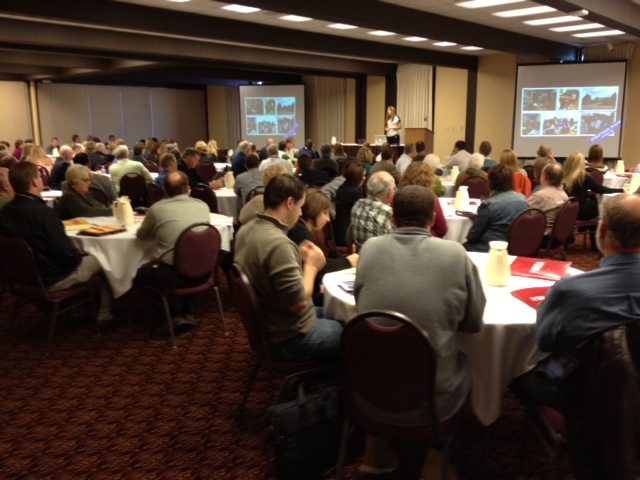 Katie Morrow, a distinguished educator and technology integrationist, spoke today at the MREA Conference on the modern day classroom and role choice, challenge and community plays in academic achievement.
Katie Morrow, a distinguished educator and technology integrationist, spoke today at the MREA Conference on the modern day classroom and role choice, challenge and community plays in academic achievement.
Morrow works at O’Neill Public Schools, a rural district about 3 hours outside of Omaha, Nebraska. She is a former elementary teacher currently serving as middle school teacher and technology integration specialist for O’Neill Public Schools. In this role, she has been fortunate to lead the school in a 1:1 laptop initiative called “24/7 Learning.” Get Katie’s Presentation. View resources she suggests.
“It’s not enough that we went 1:1,” Morrow said. “If you do not change the rest of it and you’re not incorporating the higher based challenges and the choices, it’s not going to be any different than it was 10 years ago.”
As a small district with 750 students in K-12, Morrow believes her district has been well-positioned to make changes more effectively. She identifies the three critical components to creating a successful modern day classroom – Choice, Challenge and Community.
Get Started Today
Morrow suggests schools take these steps to create classrooms of tomorrow:
- Entrust your students. Shift some of the control and take on some responsible risk.
- Start with the “Why.” Focus on the verbs, not the nouns. The action is most important.
- Stay in the question longer – instead of shooting straight to a solution. Ask the tough questions. Train kids and let them experience failure.
- Publish and share. Make the learning process transparent. The community should not stop at the classroom door.
- Be the change. Step across the hallway and find one teacher who you can partner with.
- Don’t just do things differently, do things that are different.
Choice
It’s no longer good enough to teach a set of lesson plans, Morrow said. Learning must be lifelong, life-wide and available on demand. Equipping students with technology like iPads allows them to choose to learn more about a subject – that maybe even their teachers do not know they’re interested in. Students like Addie, a girl who had a passion for art and used tools and expertise on the Internet to create her own pieces. Or Brett, a student who wrote book and published a book without ever receiving a grade for his work.
“We cannot just settle for being instructional centers, we really have to find ways to reach those Addies, and those Bretts to inspire their learning and help them go farther than ever before,” Morrow said.
Morrow challenged educators to move beyond the idea that education is something that is provided for students. It’s about teaching students to learn and initiating the lifelong process. Students at O’Neill have taught themselves everything from playing the guitar and doing digital photography to art and computer programming. One student’s published audios caught the attention of a recording artist on the west coast, who asked the student to sing background vocals on his new album.
“It all happened by opening up the doors,” Morrow said.”
Morrow encourages educators to “flip the classroom.” In this theory, the lectures for the classroom are recorded and students listen to them at home so teachers and students can focus more on discussion activities, application or even doing homework in the classroom.
Challenge
“I think we need to challenge our students more and technology is a great way to do that,” Morrow said. If students care about the subject matter, they are more likely to dig deeper and learn more.
Instead of lecturing on persuasive writing, Morrow challenges her 8th graders to create blogs, publish letters to the editor and other real-life applications to help show students how their writing can change minds – and change the world.
O’Neill Public Schools has implemented Challenge-based learning, or as one of her students calls it “Change-based learning.” She shared six design principles that should be evident in a classroom of tomorrow today:
- Authentic real-world problems launches the learning.
- Student directed teams, meaning students let go of some of the lesson plans
- Open-ended solutions, sometimes looking different than the teacher may have expected.
- Action-oriented because it is not enough to come up with the solution. Action is needed.
- Leverage technology throughout as a means to learning and solving the problem.
- Published globally.
It may sound similar to other learning models that teachers have used in the past. Those models are the foundation, but this model eliminates the complexity, confusion and clutter to make it simple to implement in the classroom tomorrow – literally, she said.
“It’s a mindset or a philosophy that puts students at the center,” Morrow said. “It’s about just in time learning, not just in case.”
O’Neill Schools took a bottom-up approach by starting with providing the tools to students. They did not start by training teachers and wait for teachers to receive the professional development they needed to launch the initiative. “We got it into our students’ hands first and hoped they would spread it, and they did,” she said. Their comfort level taught the rest.
“We were not happy with doing things differently, we wanted to make things different,” she said.
Community
Connecting students to a community is critical in initiating a more engaging learning environment. This can include connecting students to the local community or classrooms across the world.
- Harness the Back Channelto create classroom communities using tools such as:
- Edmodo – Facebook-like tool that is safe for schools to build community within their classrooms.
- Socrative – Allows students to click in answers for on-the spot polls or formal assessments.
- iChat – Students can connect with teachers or students to ask questions.
- Create Personal Learning Networkto connect you, as an educator, to others in the industry through:
- Symbaloo

